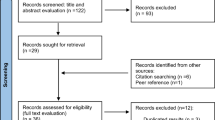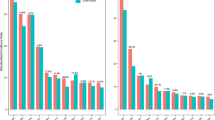Abstract
Recent meta-analyses of occupational epidemiology studies identified two important exposure data quality factors in predicting summary effect measures for asbestos-associated lung cancer mortality risk: sufficiency of job history data and percent coverage of work history by measured exposures. The objective was to evaluate different exposure parameterizations suggested in the asbestos literature using the Libby, MT asbestos worker cohort and to evaluate influences of exposure measurement error caused by historically estimated exposure data on lung cancer risks. Focusing on workers hired after 1959, when job histories were well-known and occupational exposures were predominantly based on measured exposures (85% coverage), we found that cumulative exposure alone, and with allowance of exponential decay, fit lung cancer mortality data similarly. Residence-time-weighted metrics did not fit well. Compared with previous analyses based on the whole cohort of Libby workers hired after 1935, when job histories were less well-known and exposures less frequently measured (47% coverage), our analyses based on higher quality exposure data yielded an effect size as much as 3.6 times higher. Future occupational cohort studies should continue to refine retrospective exposure assessment methods, consider multiple exposure metrics, and explore new methods of maintaining statistical power while minimizing exposure measurement error.
This is a preview of subscription content, access via your institution
Access options
Subscribe to this journal
Receive 6 print issues and online access
$259.00 per year
only $43.17 per issue
Buy this article
- Purchase on Springer Link
- Instant access to full article PDF
Prices may be subject to local taxes which are calculated during checkout
Similar content being viewed by others
References
Armstrong BG . Effect of measurement error on epidemiological studies of environmental and occupational exposures. Occup Environ Med 1998; 55: 651–656.
Silverstein MA, Welch LS, Lemen R . Developments in asbestos cancer risk assessment. Am J Ind Med 2009; 52: 850–858.
Lenters V, Vermeulen R, Dogger S, Stayner L, Portengen L, Burdorf A et al. A meta-analysis of asbestos and lung cancer: is better quality exposure assessment associated with steeper slopes of the exposure-response relationships? Environ Health Perspect 2011; 119: 1547–1555.
Lenters V, Burdorf A, Vermeulen R, Stayner L, Heederik D . Quality of evidence must guide risk assessment of asbestos. Ann Occup Hyg 2012; 56: 879–887.
Vlaanderen J, Fransman W, Miller B, Burnstyn I, Heederik D, Hurley F et al. A graphical tool to evaluate temporal coverage of occupational history by exposure measurements. Occup Env Med 2010; 67: 636–638.
White RH, Fox MA, Cooper GS, Bateson TF, Burke TA, Samet JM . Workshop report: evaluation of epidemiological data consistency for application in regulatory risk assessment. Open Epidemiol J 2013; 6: 1–8.
Hodgson JT . Quality of evidence must guide risk assessment of asbestos, by Lenters, V; Burdorf, A; Vermeulen, R; Stayner, L; Heederik, D. Ann Occup Hyg 2013; 57: 670–674.
Berman DW, Case BW . Overreliance on a single study: There is no real evidence that applying quality criteria to exposure in asbestos epidemiology affects the estimated risk. Ann Occup Hyg 2012; 56: 869–878.
Berman DW, Case BW . Quality of evidence must guide risk assessment of asbestos, by Lenters, V; Burdorf, A; Vermeulen, R; Stayner, L; Heederik, D. Ann Occup Hyg 2013; 57: 667–669.
Heederik D, Lenters V, Vermeulen R . Reply: response to the letter by Drs Berman and Case. Ann Occup Hyg 2013; 57: 675–677.
Amandus HE, Wheeler R . The morbidity and mortality of vermiculite miners and millers exposed to tremolite-actinolite: Part II. Mortality. Am J Ind Med 1987; 11: 15–26.
Sullivan PA . Vermiculite, respiratory disease, and asbestos exposure in Libby, Montana: update of a cohort mortality study. Environ Health Perspect 2007; 115: 579–585.
Berman DW, Crump KS . Update of potency factors for asbestos-related lung cancer and mesothelioma. Crit Rev Toxicol 2008; 38 (Suppl. 1): 1–47.
Larson TC, Antao VC, Bove FJ . Vermiculite worker mortality: estimated effects of occupational exposure to Libby amphibole. J Occup Environ Med 2010; 52: 555–560.
Moolgavkar SH, Turim J, Alexander DD, Lau EC, Cushing CA . Potency factors for risk assessment at Libby, Montana. Risk Anal 2010; 30: 1240–1248.
NAS (National Academy of Sciences). Asbestos: Selected Cancers. National Academies Press: Washington, DC. 2006.
Jahr J . Dose-response basis for setting a quartz threshold limit value. Arch Environ Health 1974; 29: 338–340.
Berry G, Gilson JC, Holmes S, Lewinsohn H, Roach S . Asbestosis: a study of dose-response relationships in an asbestos textile factory. Br J Ind Med 1979; 36: 98–112.
Bilgrad R . National Death Index Plus: Coded Causes of Death: Supplement to the National Death Index User’s Manual. Centers for Disease Control and Prevention: Hyattsville, MD. 1997.
Meeker GP, Bern AM, Brownfield IK, Lowers HA, Sutley SJ, Hoefen TM et al. The composition and morphology of amphiboles from the Rainy Creek complex, near Libby, Montana. Am Mineral 2003; 88: 1955–1969.
McDonald JC, McDonald AD, Armstrong B, Sebastien P . Cohort study of mortality of vermiculite miners exposed to tremolite. Br J Ind Med 1986; 43: 436–444.
McDonald JC, Harris J, Armstrong B . Cohort mortality study of vermiculite miners exposed to fibrous tremolite: an update. Ann Occup Hyg 2002; 46: 93–94.
McDonald JC, Harris J, Armstrong B . Mortality in a cohort of vermiculite miners exposed to fibrous amphibole in Libby, Montana. Occup Environ Med 2004; 61: 363–366.
Amandus HE, Wheeler R, Jankovic J, Tucker J . The morbidity and mortality of vermiculite miners and millers exposed to tremolite-actinolite: Part I. Exposure estimates. Am J Ind Med 1987; 11: 1–14.
Newhouse ML, Berry G . Predictions of mortality from mesothelial tumours in asbestos factory workers. Br J Ind Med 1976; 33: 147–151.
Cook PJ, Doll R, Fellingham SA . A mathematical model for the age distribution of cancer in man. Int J Cancer 1969; 4: 93–112.
Berry G, Wagner JC . The application of a mathematical model describing the times of occurrence of mesotheliomas in rats following inoculation with asbestos. Br J Cancer 1969; 23: 582–586.
Berry G . Models for mesothelioma incidence following exposure to fibers in terms of timing and duration of exposure and the biopersistence of the fibers. Inhal Toxicol 1999; 11: 111–130.
Churg A, Vedal S . Fiber burden and patterns of asbestos-related disease in workers with heavy mixed amosite and chrysotile exposure. Am J Respir Crit Care Med 1994; 150: 663–669.
Finkelstein MM, Dufresne A . Inferences on the kinetics of asbestos deposition and clearance among chrysotile miners and millers. Am J Ind Med 1999; 35: 401–412.
Berry G, Pooley F, Gibbs A, Harris JM, McDonald JC . Lung fiber burden in the Nottingham gas mask cohort. Inhal Toxicol 2009; 21: 168–172.
Cox DR . Regression models and life tables. JRSS Series B 1972; 34: 187–220.
Burnham KP, Anderson DR . Model Selection and Multimodel Inference: A Practical Information-Theoretic Approach 2nd edn 2002.
Richardson DB . Occupational exposures and lung cancer: adjustment for unmeasured confounding by smoking. Epidemiology 2010; 21: 181–186.
Acknowledgements
We are grateful to Patricia Sullivan of the National Institute for Occupational Safety and Health, Danielle DeVoney of the US EPA’s Office of Solid Waste and Emergency Response and anonymous reviewers. No direct funding for this work was received from any source; general support for this work was provided by the National Center for Environmental Assessment, US Environmental Protection Agency.
Disclaimer
The views expressed in this article are those of the authors and do not necessarily represent the views or policies of the US Environmental Protection Agency.
Author information
Authors and Affiliations
Corresponding author
Ethics declarations
Competing interests
The authors declare no conflict of interest.
Rights and permissions
About this article
Cite this article
Bateson, T., Kopylev, L. Influence of exposure assessment and parameterization on exposure response. Aspects of epidemiologic cohort analysis using the Libby Amphibole asbestos worker cohort. J Expo Sci Environ Epidemiol 25, 12–17 (2015). https://doi.org/10.1038/jes.2014.3
Received:
Accepted:
Published:
Issue Date:
DOI: https://doi.org/10.1038/jes.2014.3
Keywords
This article is cited by
-
The impact of different approaches to exposure assessment on understanding non-malignant respiratory disease risk in taconite miners
International Archives of Occupational and Environmental Health (2020)



